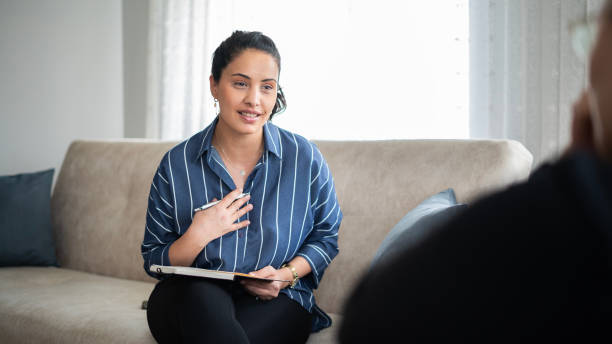What OCD really is often gets lost in translation. While many people casually associate OCD with neatness or being “a little controlling”, the truth is far more serious—and far more misunderstood. As an OCD Counselor in Woodland Hills, I know that Obsessive Compulsive Disorder is nothing to joke about or make light of. For those who live with OCD, it’s not about loving a clean house, or enjoying having an organized closet. OCD behaviors don’t make you happy or give you satisfaction. OCD involves battling intrusive thoughts and anxiety that feel impossible to ignore.

What Is What Is OCD, Really?
What does OCD actually look like? Obsessive-Compulsive Disorder (OCD) is a chronic mental health condition involving obsessions (unwanted, intrusive thoughts) and compulsions (behaviors or mental acts aimed at reducing distress). It’s not about preferences—it’s about survival, distress, and an exhausting mental loop.
- Common Symptoms of OCD:
- Obsessions: Recurrent, distressing thoughts (e.g., fears of harm, contamination, or moral failure).
- Compulsions: Repetitive behaviors or rituals done to relieve anxiety (e.g., checking, counting, seeking reassurance).
- Avoidance behaviors: Avoiding people, places, or activities that might trigger obsessive thoughts.
- Mental compulsions: Repeating prayers, phrases, or mentally reviewing events to “neutralize” anxiety.
- Distress and impairment: Symptoms significantly interfere with daily functioning, relationships, and/or self-esteem
2 Tools to Understand and Respond to OCD More Accurately
1 – Challenge the Stereotypes

It can feel vulnerable to speak up against stereotypes, especially those that are dropped casually and/or taken lightly. You may feel hurt and offended by these stereotypes, and unsure of how to bring up the conversation.
- Understand what OCD is and what it isn’t. OCD is not just about cleanliness, order, or quirks—it can involve dark, scary, or deeply uncomfortable thoughts that people don’t talk about. These can be the types of thoughts that can cause you to doubt yourself, to worry that you aren’t well enough to navigate life, and that cause unbearable strain on your day to day life. You may experience a thought that you know isn’t true, or doesn’t reflect who you truly are and how you truly feel, but find that you are unable to let go of it. Fear of your thoughts and the opinions of others can lead to isolation and shame. Thanks to an evolving understanding of what Obsessive Compulsive Disorder is and how it manifests, diagnostic criteria have changed in the past couple of decades. Neither you nor anyone around you benefits from outdated interpretations and caricatures of someone with OCD.
- Be aware of the different ways that OCD can manifest. Some types of OCD are considered taboo; a fear around discussing the accompanying thoughts and compulsions can contribute to them being lesser-known. There are many subtypes of OCD that often go unnoticed or under-represented:
- Harm OCD (fear of hurting others) is a subtype that many people don’t know exists, and can be quite frightening when it occurs. This type of OCD might involve a fear of harming a loved one or pet, or hitting a stranger with your car. This can lead to distress when navigating daily life, such as caring for those you love or commuting to and from work.
- Relationship OCD (doubting your feelings for a partner) can manifest as constantly seeking reassurance about the relationship and its viability, obsessing about the calibre of partner, or avoidance of relationships altogether.
- Sexual obsessions (experiencing urges or visualizing imagery that often doesn’t align with your sexual pleasure and satisfaction) can bring sexuality to the forefront of your thoughts and concerns. Taboo thoughts can lead to deep shame and fear of subconscious meanings, even when these thoughts have no basis in actual preferences and behaviors.
- Religious obsessions (intrusive thoughts and worries about moral quandaries) can lead to persistent fear of having sinned, or being bound to eternal suffering.
- “Pure O” OCD (obsessions without obvious compulsions) suffer the intrusive and persistent thoughts of OCD and may be partaking in internal compulsions, but those are mental as opposed to physical. This may include a silent, internal world of ruminating, repeating words or phrases, and rehashing the past.
- Educating yourself (and others) helps reduce shame and increase empathy. When the people around you understand OCD, they are able to demonstrate to you that you are more than your intrusive thoughts. The better you understand OCD and how it impacts you, the more capable you are to explain to those with whom you spend time what is going on and how they can support you. Feeling understood and safe can go a long way towards navigating daily life, even if you are the only person you know who has OCD.
2 – Learn About ERP (Exposure and Response Prevention)

Exposure and Response Prevention is something that many people who have OCD find that they have been forced to do on their own, to some degree. There will always be situations in life when you aren’t able to control your environment enough to protect you from triggers. What ERP therapy does is provide a safe, regulated, and guided space in which to address fears, obsessions, and compulsions.
- ERP is the gold-standard treatment for OCD—it involves gradually facing your fears without performing the compulsion. We offer ERP in our Woodland Hills OCD therapy sessions, and understand that each person will have a unique relationship with the process. Exposures can be real or imagined, depending on what the trigger is. In the case when it is unreasonable and/or unsafe to confront an exposure in real life, imagining it in a controlled environment is the next best thing. You can be guided through an imagined experience and confront it in ways that help to improve your feelings of wellbeing. When applicable, you may begin with imagined exposures and move toward real-life interactions as well. This may be in scenarios where there is little to no risk of harm or danger, or in scenarios where it is deemed necessary to overcome the issue, such as being able to drive on a road that you cannot avoid in your commute. Exposure and Response Prevention is just that: confronting a trigger and working to avoid the compulsion that usually accompanies it. When you are able to adjust your response to your intrusive thoughts and obsessions, you can strengthen your grip on the ins and outs of your life. Taking control of your actions can be hard-won, but it is possible with ERP.
- ERP is a gradual process, and it requires consistency. Most of us avoid the things that make us uncomfortable; in that way, taking on ERP can feel like running into a danger zone. While uncomfortable at first, ERP retrains the brain to tolerate uncertainty and reduce the power of obsessive thoughts. Every time you face an exposure and get through it, your brain learns that you were safe in that circumstance, despite any fears of the contrary. That doesn’t mean that you are suddenly able to confront everything that triggers you, or step away from the compulsions that you are used to, but what it does mean is that you can reduce the anxiety and fear surrounding taking on your OCD triggers. At first, the idea of resisting a compulsive action for even a minute may seem unbearable. Over time, you may be able to delay and even completely forego the compulsive behaviors that accompany your triggers and compulsions. Some days will be easier than others; progress will not be linear. But you can see improvements over time if you keep at it.
- Regular talk therapy has its place, but addressing obsessions and compulsions works best when done in the care of an OCD professional. Even if you see a therapist already, if they aren’t trained in how to address OCD and administer ERP, you may need to see someone else in order to address the specifics of navigating your OCD. Find a therapist trained in OCD-specific treatment, not just general talk therapy. OCD needs targeted intervention to improve. Those who see us for OCD Therapy in Woodland Hills receive specialized support for their OCD. This doesn’t take anything away from therapists who are not trained in OCD; it is about getting the best care for yourself that you can.
Key Takeaways

- OCD is a serious, often misunderstood condition—not a personality quirk or desire for perfection.
- It involves unwanted thoughts and compulsive behaviors that cause deep distress.
- Education, empathy, and evidence-based treatment are key to support and recovery.
- Those who have OCD can benefit from in-person or online OCD therapy that includes Exposure and Response Prevention.
- Navigating OCD can take time and focus; small changes and adjustments can nurture life-changing tactics and routines if you are patient with yourself.
How Therapy Can Help
OCD-informed therapy, especially Exposure and Response Prevention (ERP), can significantly reduce symptoms and improve quality of life. A therapist can help you understand your unique thought patterns, face feared situations, and reclaim your mental space. You are not your OCD—and with support, healing is possible.
OCD Treatment in Woodland Hills
OCD goes far beyond hand-washing or double-checking locked doors. It can affect many parts of life, including relationships, driving, and even the postpartum experience. To truly understand the OCD cycle and begin making lasting changes, specialized support is key. Our OCD specialist—available in Woodland Hills or virtually—offers evidence-based treatment that includes Exposure and Response Prevention (ERP), Cognitive Behavioral Therapy (CBT), Acceptance and Commitment Therapy (ACT), and mindfulness techniques to help you regain control and improve your quality of life.
Contact us today for your complimentary 20-minute phone consultation with our Admin Team today!



